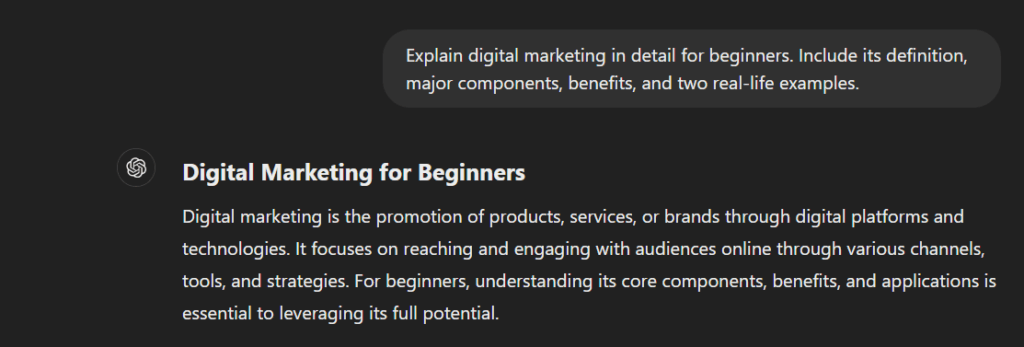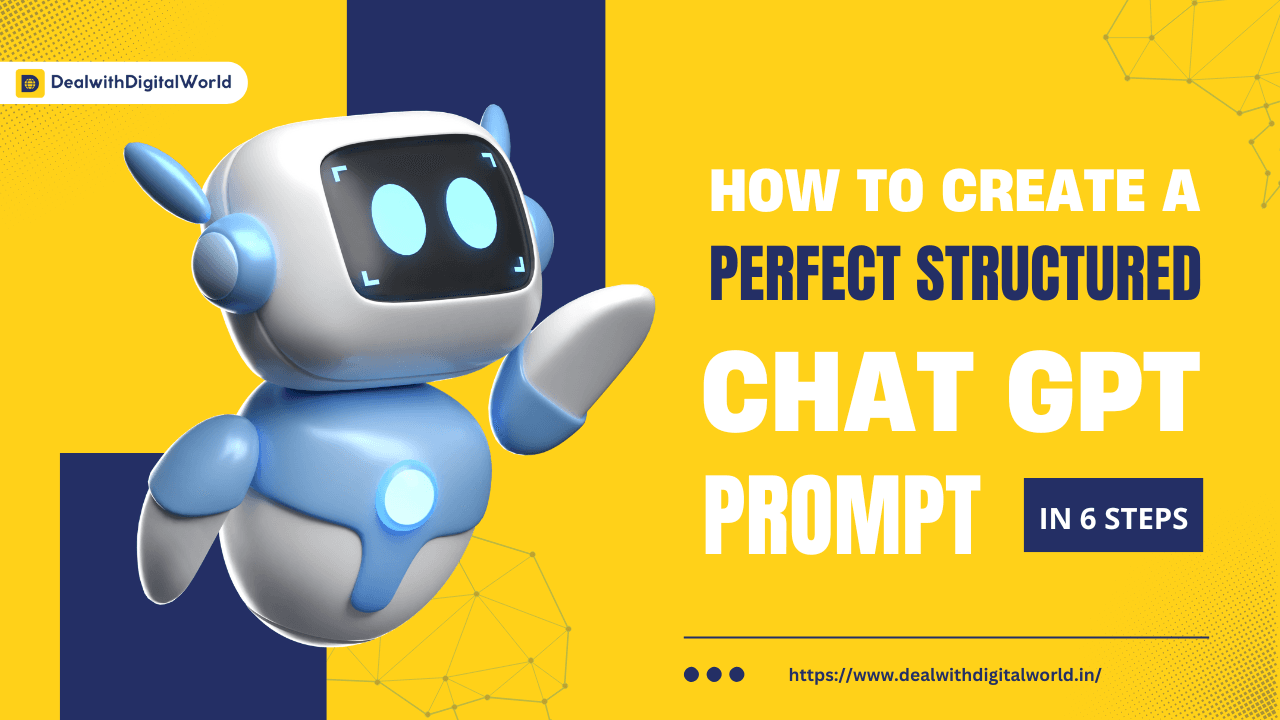How Prompts Work
1. Normal Prompt Example:
Prompt: “Explain digital marketing.”
AI Response: “Digital marketing is use of online channels to promote products or services.”

Issue: While correct, response is too broad and lacks depth. Lack of detail in prompt limits AI’s ability to provide a comprehensive answer.
2. Structured Prompt Example:
Prompt: “Explain digital marketing in detail for beginners. Include its definition, major components, benefits, and two real life examples.”
AI Response:
“Digital marketing is use of online platforms like social media, email, and search engines to promote products or services. Major components include SEO, content marketing, email marketing, and social media marketing. Benefits include cost effectiveness, global reach, and measurable results.
- Example 1: A small bakery uses Instagram to post pictures of their cakes and runs promotions to attract local customers.
- Example 2: A startup uses Google Ads to target specific keywords to reach potential buyers globally.”

Why It’s Better: Structured prompt provides specific instructions, guiding AI to give a detailed and well rounded response.
What is a Prompt?
A prompt is a request or instruction given to an AI to generate a response. Quality of response depends on clarity and structure of prompt.
Why is a Structured Prompt Important?
Structured prompts help AI understand your request better, leading to more accurate, useful, and relevant responses. Without structure, AI might interpret query in unintended ways.
Components of a Structured Prompt
To create a structured prompt:
- Start with Context: Clearly state what you want.
Example: “Explain digital marketing…” - Add Specific Details: Define scope or aspects to cover.
Example: “… in detail for beginners, including definition, components, and benefits.” - Request Examples or Format: Ask for real world examples or a specific output format.
Example: “… with two real life examples.”
Differentiation: Normal Prompt vs Structured Prompt
| Aspect | Normal Prompt | Structured Prompt |
| Clarity | Vague or broad | Clear and specific |
| Depth of Response | Brief, lacks detail | Detailed and comprehensive |
| Relevance | May miss important aspects | Covers exactly what is requested |
| Example | “Define AI.” | “Define AI, explain its applications, and provide 2 examples.” |
Detailed Example Using These 6 Steps
Scenario: Writing About Renewable Energy
- Objective: Explain importance of renewable energy.
- Context: Focus on environmental impact and sustainability.
- Details: Cover benefits, types of renewable energy, and challenges.
- Format: Use bullet points for clarity.
- Examples: Include examples of solar and wind energy applications.
- Limitations: Avoid technical jargon and keep tone simple.
How to Create a Perfect Structured Chat GPT Prompt in 6 Steps
Define Objective
Start by clearly stating your goal. What do you want AI to achieve or answer?
- Example: Instead of saying, “Write about fitness,” specify, “Write about the benefits of fitness for working professionals.”
Why?
This step ensures AI focuses on purpose of your request, avoiding generic or irrelevant responses.
Provide Context
Give background information or set stage. Context helps AI understand the scope of query.
- Example: If you’re asking about marketing, specify, “Explain marketing strategies for small businesses.”
Why?
Without context, response may apply to a general audience and fail to meet specific needs.
Add Specific Details
List the key aspects or points you want AI to cover.
- Example: Instead of “Explain marketing,” write, “Explain marketing, focusing on digital tools, benefits, and strategies for local businesses.”
Why?
Specificity guides AI to include all essential components, ensuring completeness.
Request a Format
Specify how you want response to be presented—bullet points, paragraphs, comparisons, examples, etc.
- Example: “Explain in a table format the advantages and disadvantages of solar energy.”
Why?
A defined format makes response easy to read, organize, and use.
Include Examples or Scenarios
Ask for real life examples or applications to make response practical and relatable.
- Example: “Explain AI applications in healthcare with two examples of real world use cases.”
Why?
Examples add depth and help contextualize response for better understanding.
Set Limitations or Emphasis
Define any boundaries or areas to focus on, such as word count, tone, or exclusions.
- Example: “Summarize the benefits of meditation in 100 words without mentioning religion.”
Why?
This ensures response stays relevant and adheres to specific requirements.
Prompt:
“Explain the importance of renewable energy in bullet points. Focus on environmental impact and sustainability. Cover benefits, types of renewable energy, and challenges. Provide examples of solar and wind energy applications. Use simple language suitable for a general audience.”
Result:
- Renewable energy reduces greenhouse gas emissions, combating climate change.
- Types include solar, wind, hydro, and geothermal energy.
- Solar energy powers homes and businesses with rooftop panels.
- Wind energy generates electricity through wind turbines in farms.
- Challenges include high initial costs and weather dependency.
- Sustainability benefits include a reduced carbon footprint and infinite energy sources.
Comparison: Normal vs Structured Prompt
| Aspect | Normal Prompt | Structured Prompt |
| Prompt | “Write about renewable energy.” | “Explain the importance of renewable energy, focusing on environmental impact, benefits, and examples of solar and wind energy.” |
| Response | “Renewable energy is energy from natural sources.” | Detailed points covering benefits, challenges, and examples. |

